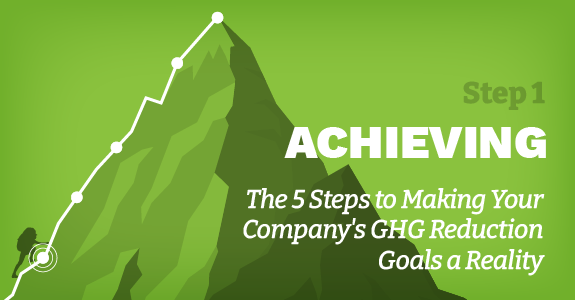
Step 1: Delivering on ESG Promises
Successfully measuring and demonstrating your organization’s environmental impact isn’t just possible – it’s achievable.
June 8, 2022
By: Mark Hall & Scott Churbock
THE FIRST IN A FIVE-STEP BLOG SERIES
We’ve powered through new challenges and opportunities in 2022. However, climate change and sustainability are still top of mind for global C-level business leaders. Organizations are looking for ways to make sustainability a cornerstone of their business strategy, operations, and corporate culture. Earlier this year we reviewed Deloitte’s 2022 CXO Sustainability Report and some interesting statistics and observations popped out to us. These were:
- Roughly two-thirds of executives participating said their organizations are very concerned about climate change and 79% see the world at a climate change tipping point – a drastic increase from 59% in a similar Deloitte survey taken in early 2021.
- While companies are acting, they are less likely to implement actions that demonstrate they have embedded climate considerations into their cultures. In part, because of the difficulty to define these actions despite feeling a moderate-to-large degree of pressure to act on climate change from many different stakeholder groups.
- Nearly a third of CXOs said the difficulty of measuring their organizations’ environmental impact was a top barrier to defining sustainability priorities.
These survey results make it clear that CXOs see climate change as a major issue and want to ensure their organizations are doing their part to address it. However, confusing guidelines and perceived barriers are often hindering efforts to demonstrate a positive impact. These efforts include the ability to truly understand an organization’s greenhouse gas (GHG) emissions and determining the best strategies to achieve meaningful reductions. As with most problems, the need for accurate, reliable, and quantifiable data is the key to making good decisions.
Bridging the Gap
There are keys to develop and implement a response strategy more effectively. We suggest focusing on three areas that can drive your program’s success.
- There has been a veritable explosion of tools, frameworks and initiatives that target or relate to benchmarking, which makes it incredibly difficult to even begin to understand where to start. For the most part, there are leading frameworks for many market segments including oil & gas and automotive. Industry associations can provide guidance on the methods applicable to their members’ operations. But there is often little consistency between these frameworks.
- Accurate baseline data is critical to making good decisions. However, many of the existing tools attempt to simplify this process by making assumptions to allow for easier calculations. This leads to confusion and makes it even harder to develop a good understanding of how reductions can be prioritized, especially when there is uncertainty whether the emissions are being accurately quantified.
- Effective measurement and evaluation of baseline data should be the foundation for a robust reduction strategy. It may be necessary to present data in multiple ways to provide a bridge between partial emission estimations that satisfy a reporting requirement to an accurate representation of total emissions. Credibility with stakeholders should be the focus, particularly if data will be publicly reported during the implementation of reduction plans.
What’s next?
Our team will be exploring these three areas more deeply in this five-step blog series. Our goal is to help provide you with a roadmap to make a positive climate impact while engaging with your stakeholders. Please join us for these upcoming blogs! As always, we are here to answer any questions you may have on your ESG journey. We look forward to helping you and your company achieve your GHG reduction goals.
The 5 Steps to Making Your Company’s GHG Reduction Goals a Reality

ACHIEVING:
Delivering on ESG Promises: Successfully measuring and demonstrating your organization’s environmental impact isn’t just possible – it’s achievable.
ACHIEVING Co-Authors
Mark Hall
SVP, Environmental Advisory Services
Mark leads our Advisory Services Team, supporting our oil & gas, manufacturing, renewable energy and power generation clients with management consulting support to assist in developing world class strategies to address their biggest environmental and sustainability challenges. Mark also provides leadership for our Consulting Services teams in the West and Central Regions and the Ecosystem Consulting service line. With over 30 years of experience in a variety of senior executive and leadership roles with both public and private power generation and renewable energy companies, as well as consulting/engineering firms, Mark’s corporate responsibilities have included strategic planning, EH&S programs, government affairs, marketing & communications, investor relations and business development. Mark is active in several trade associations and was a founding board member and past chair of the US Combined Heat and Power Association where he testified before Congress and organized and chaired three international conferences. He holds a Master’s degree in Environmental Science from Indiana University, and a Bachelors of Arts in Chemistry from Austin College.
Scott Churbock
SVP, Enterprise Risk & Regulatory Affairs
Scott Churbock is Senior Vice President of Enterprise Risk and Regulatory Affairs at Montrose Environmental Group, Inc. Mr. Churbock brings 25 years of organizational management experience to the Company, with expertise in environmental compliance, sustainability, and occupational health and safety. Prior to Montrose Environmental Group, Inc., Mr. Churbock was Vice President of Environmental Health and Safety with Northern Star Generation in Houston, Texas. Mr. Churbock’s accomplishments include the implementation of ISO-based EHS management systems that led to multi-million dollar regulatory and loss prevention savings as well as injury reduction rates of more than 75% in his last two positions. Programs under his direction have received multiple leadership and excellence awards from the National Safety Council, representing top 5% performance in the industry. Mr. Churbock has a Bachelor of Science degree in Civil Engineering from the University of Pittsburgh and an MBA from Robert Morris University.








